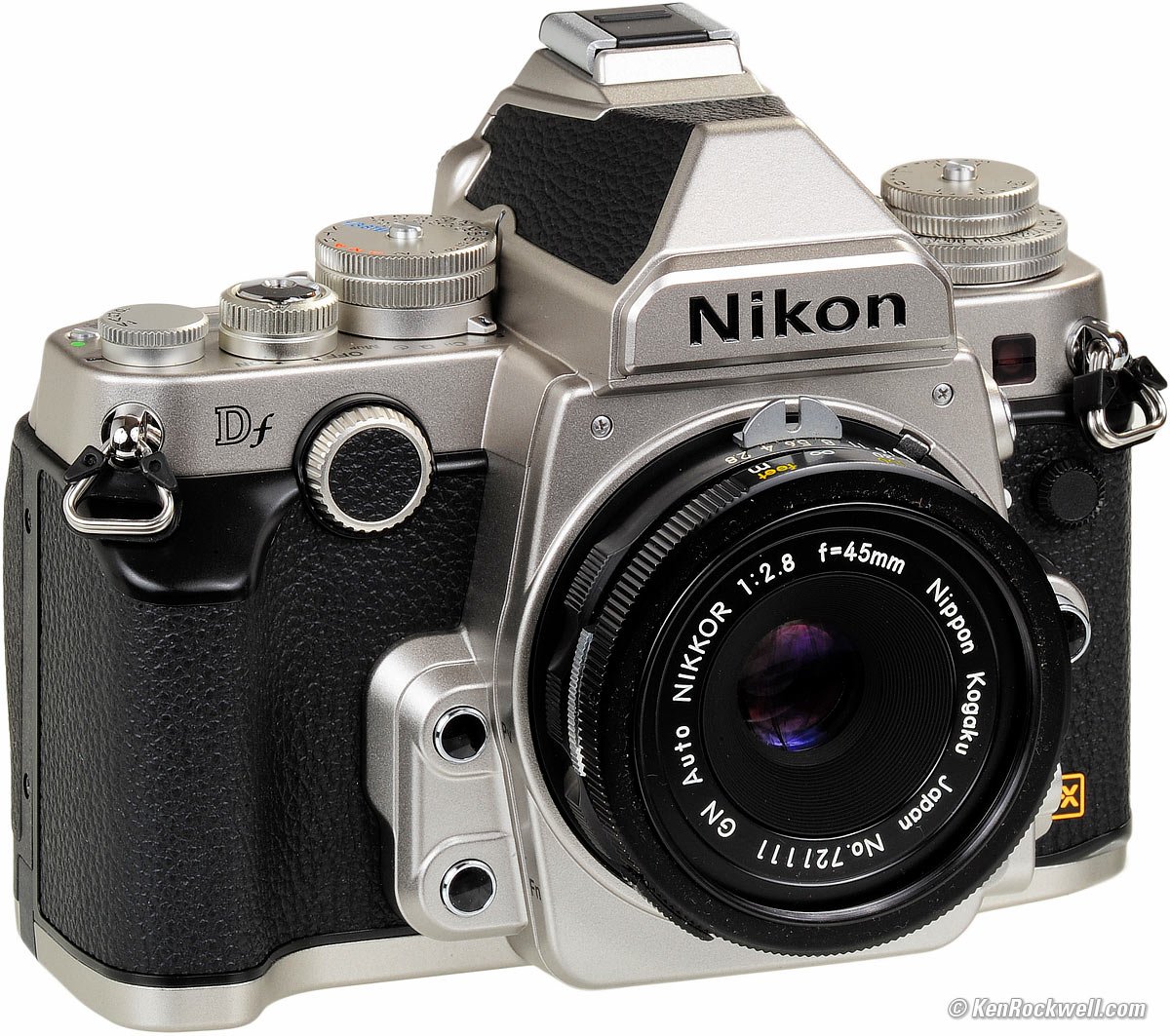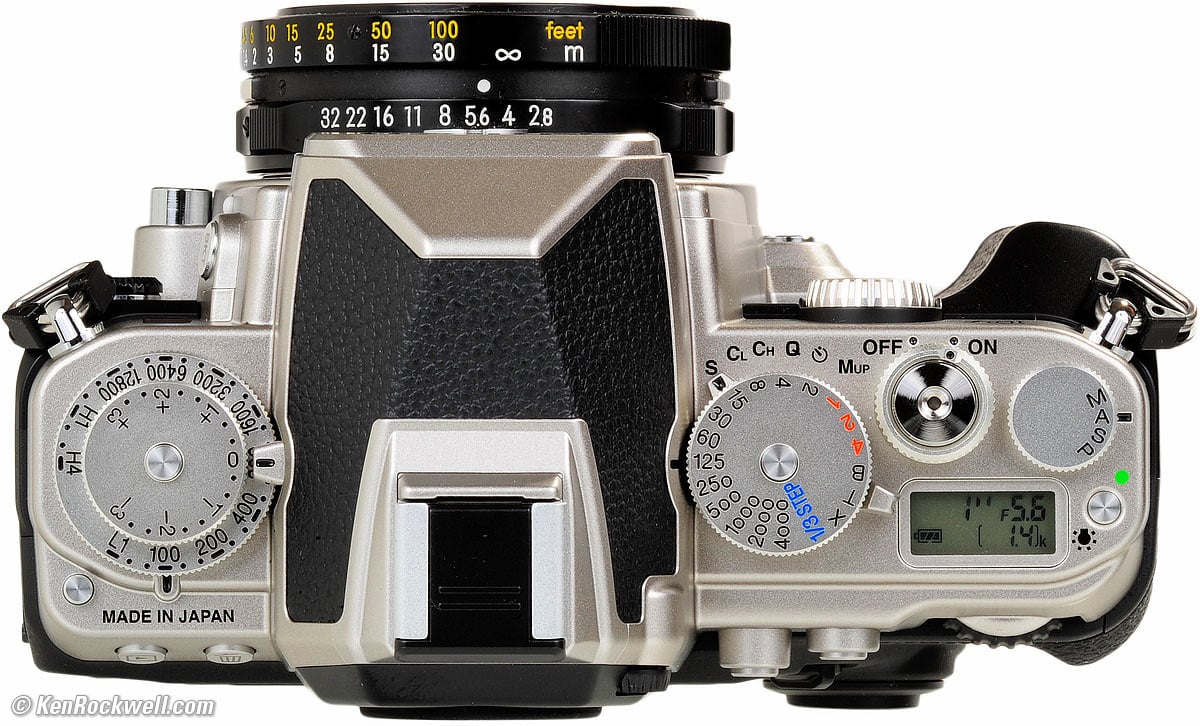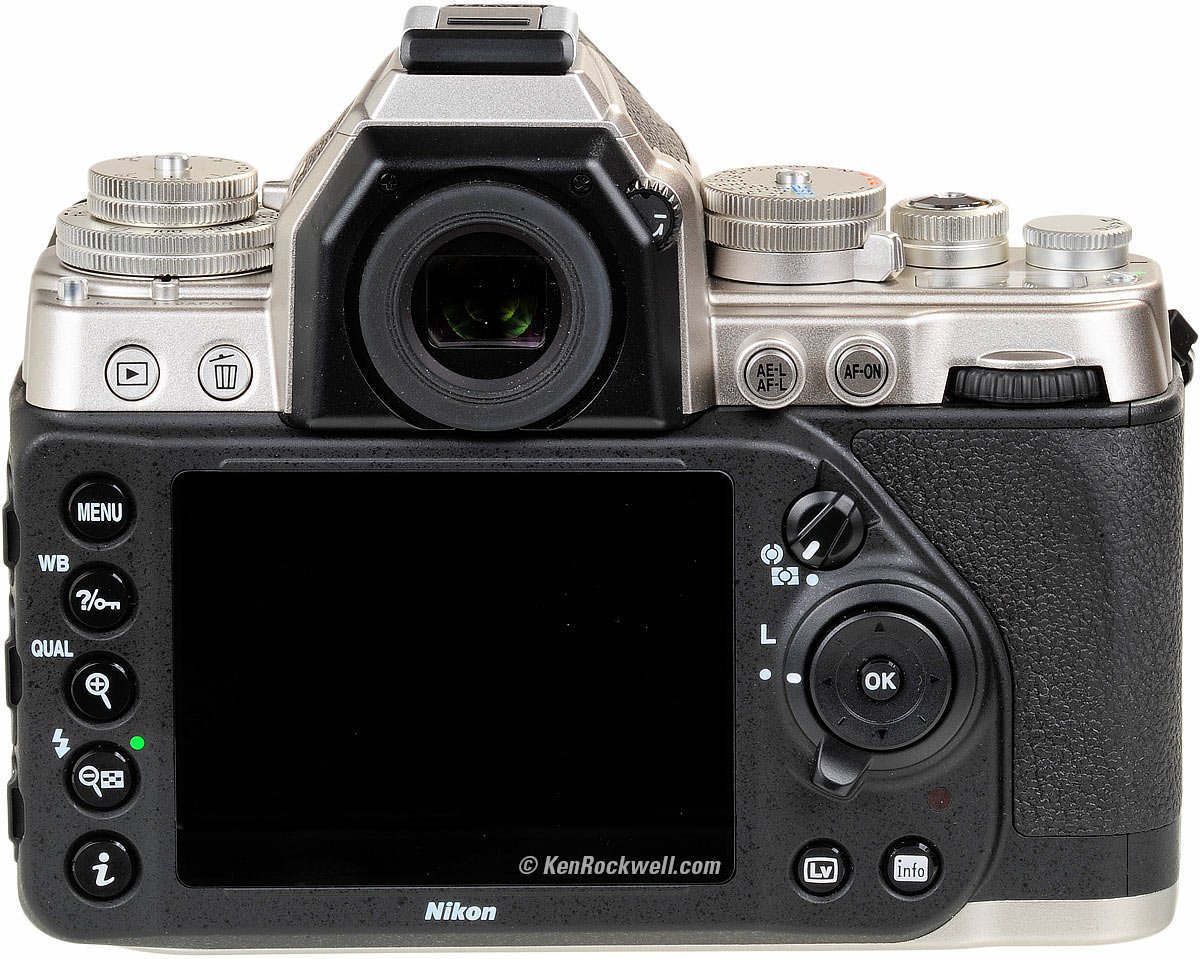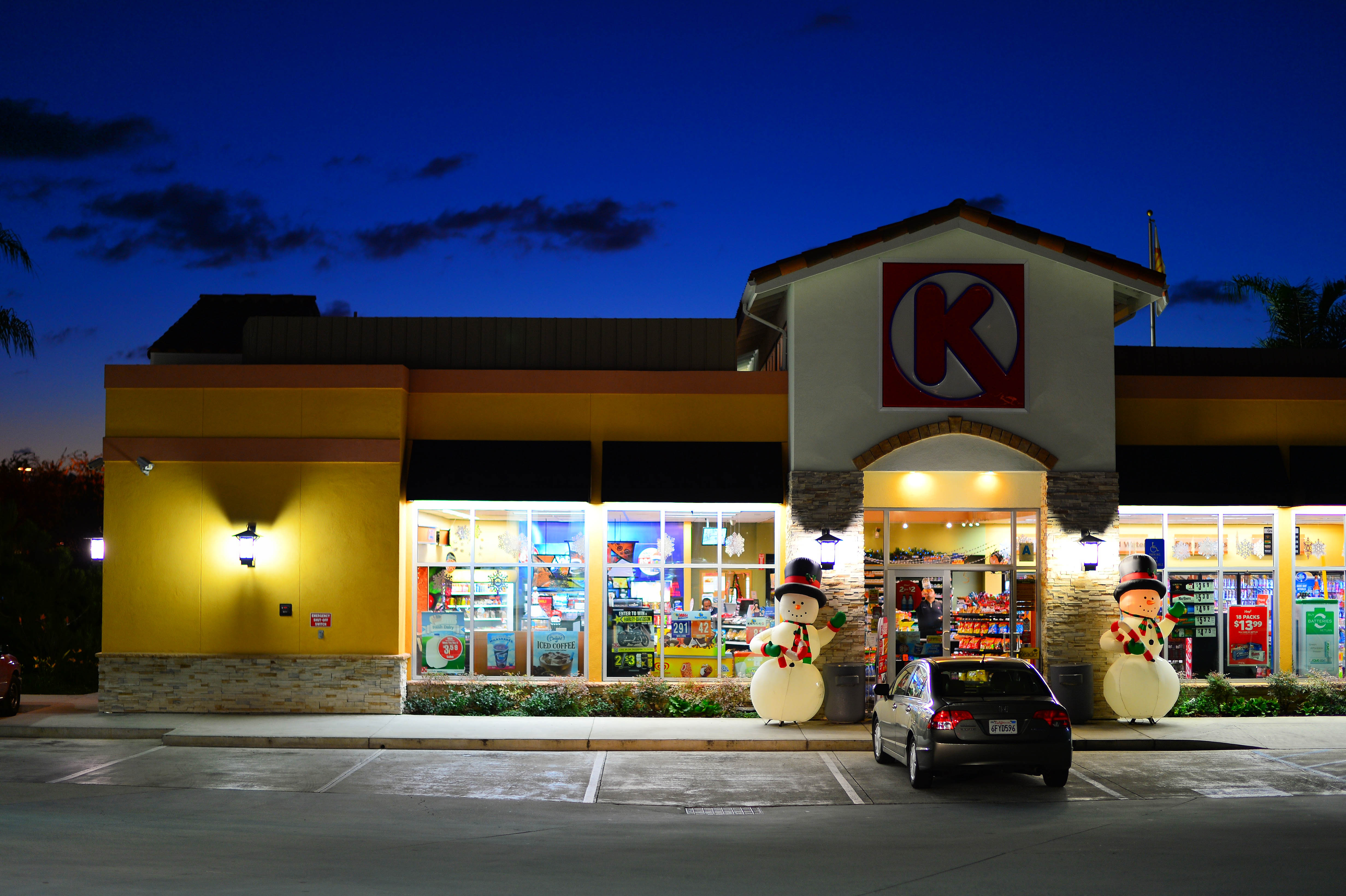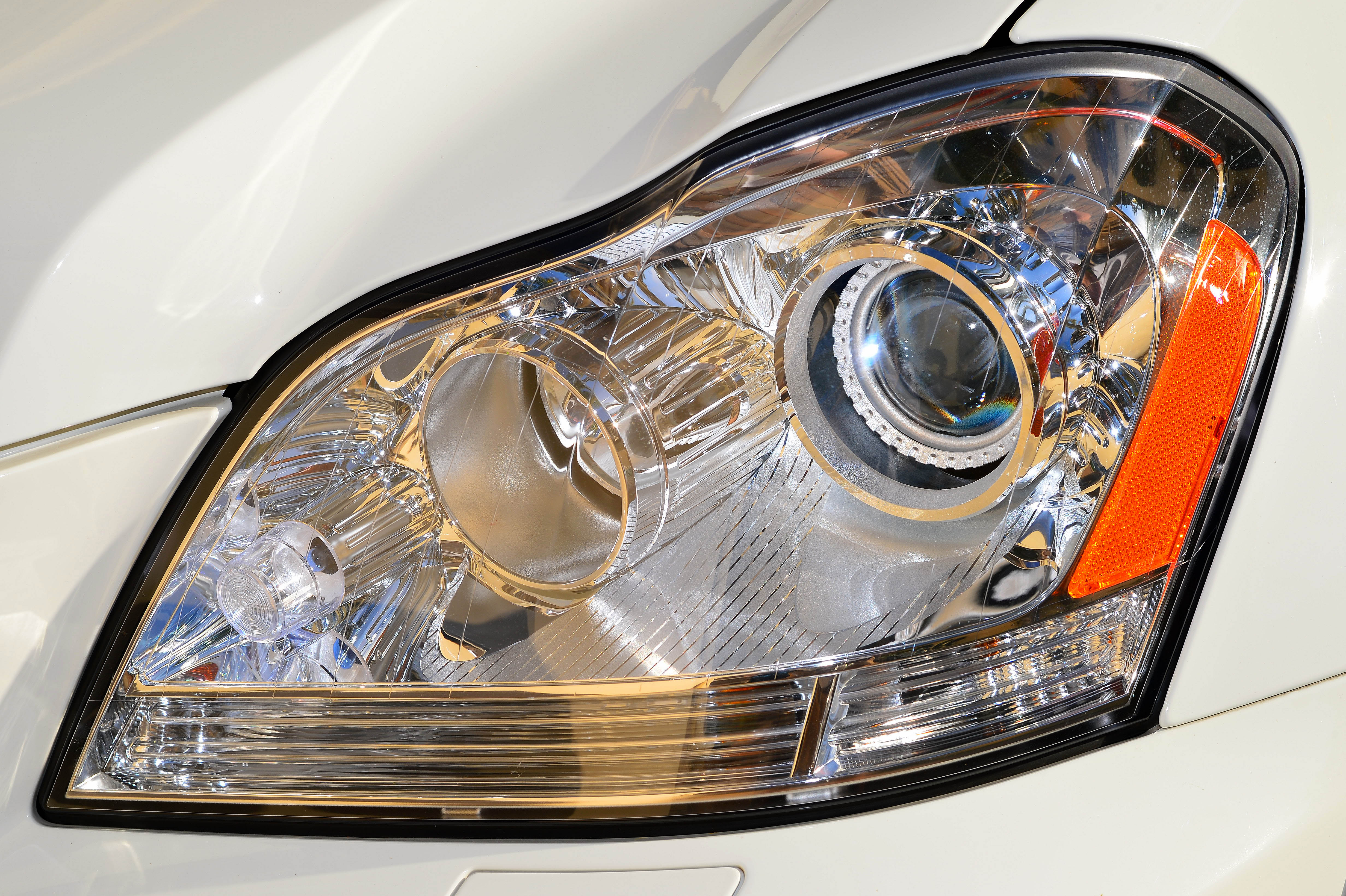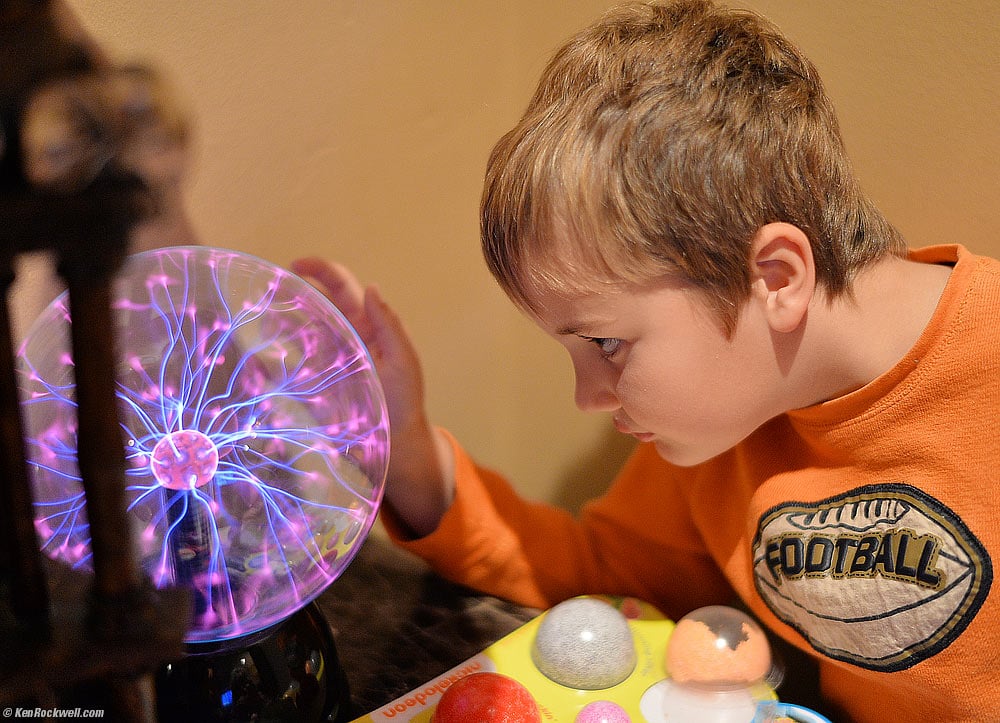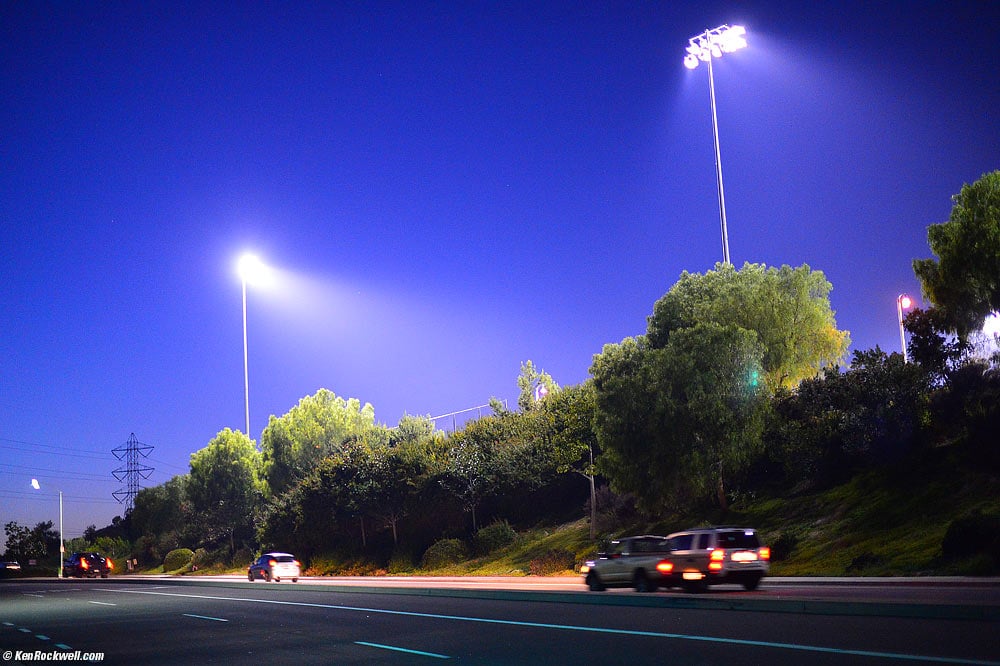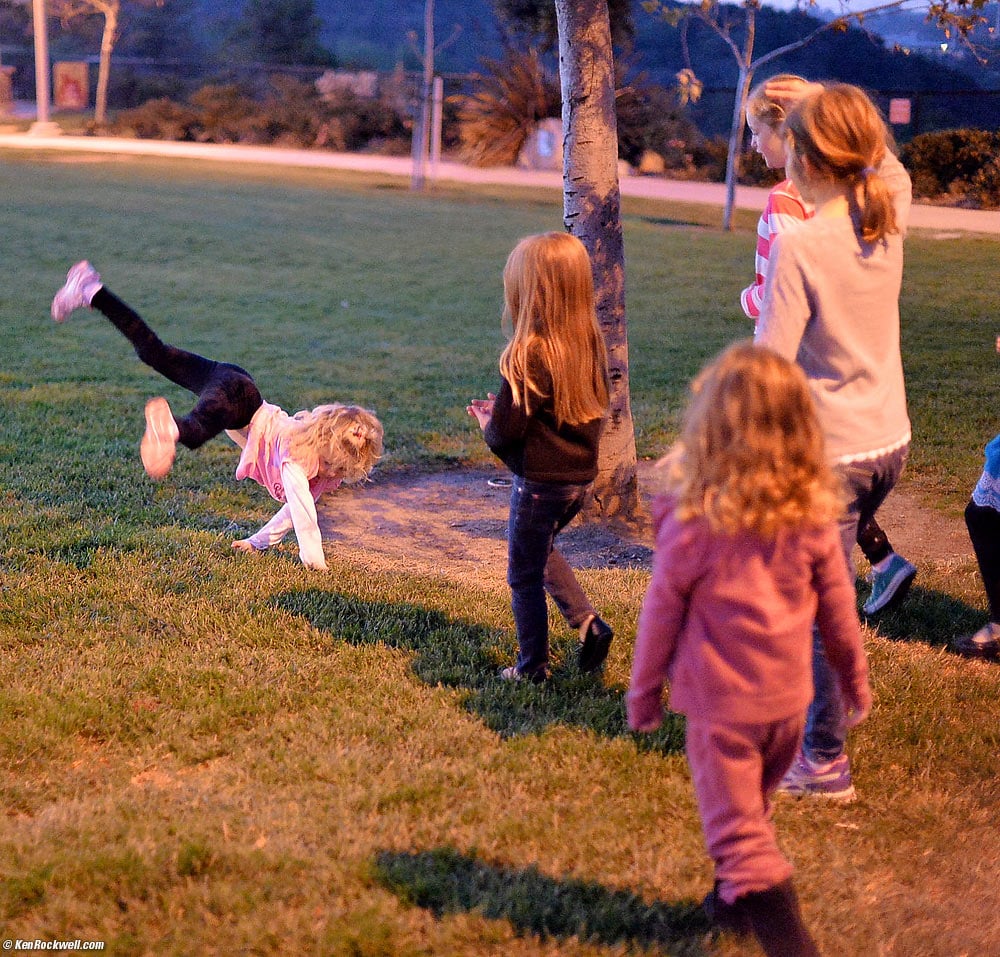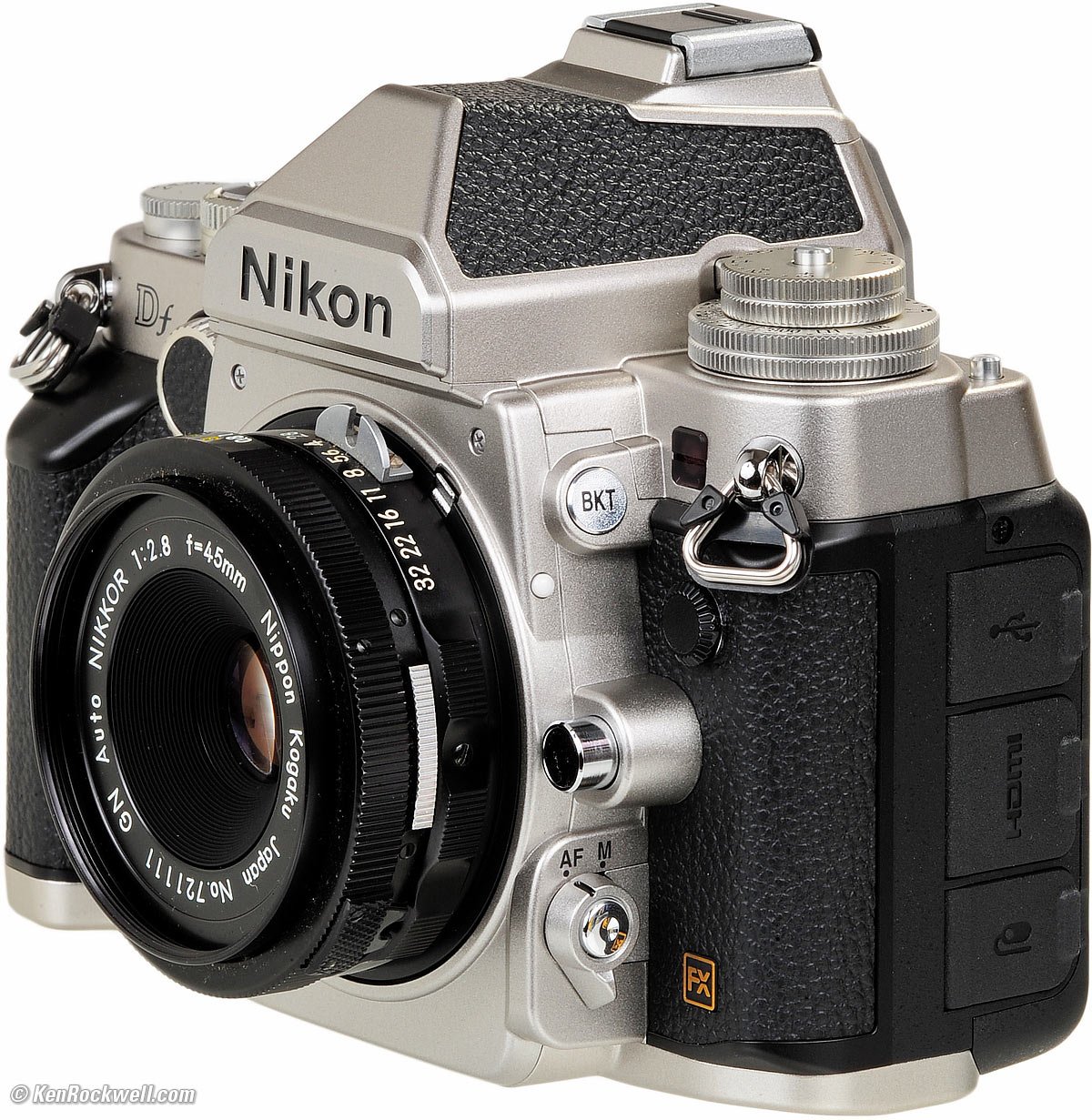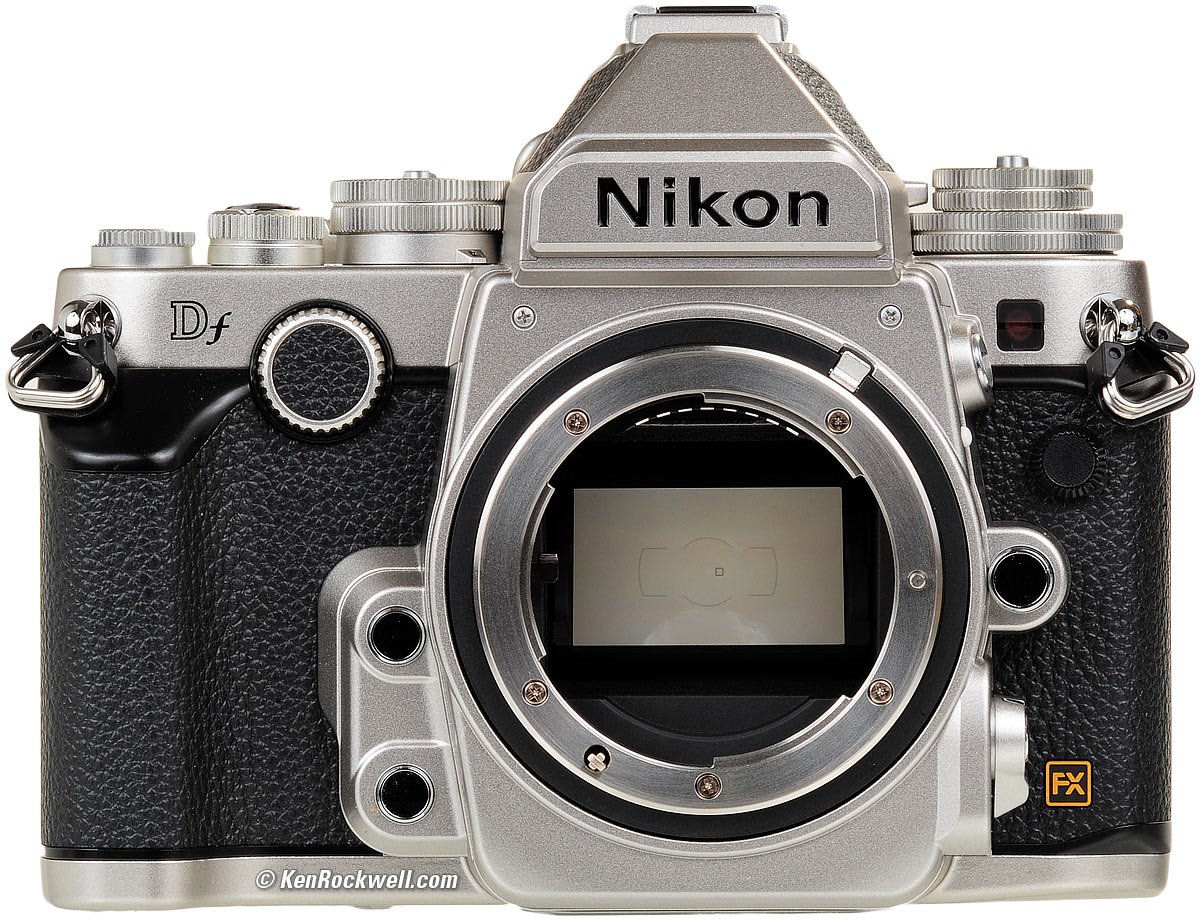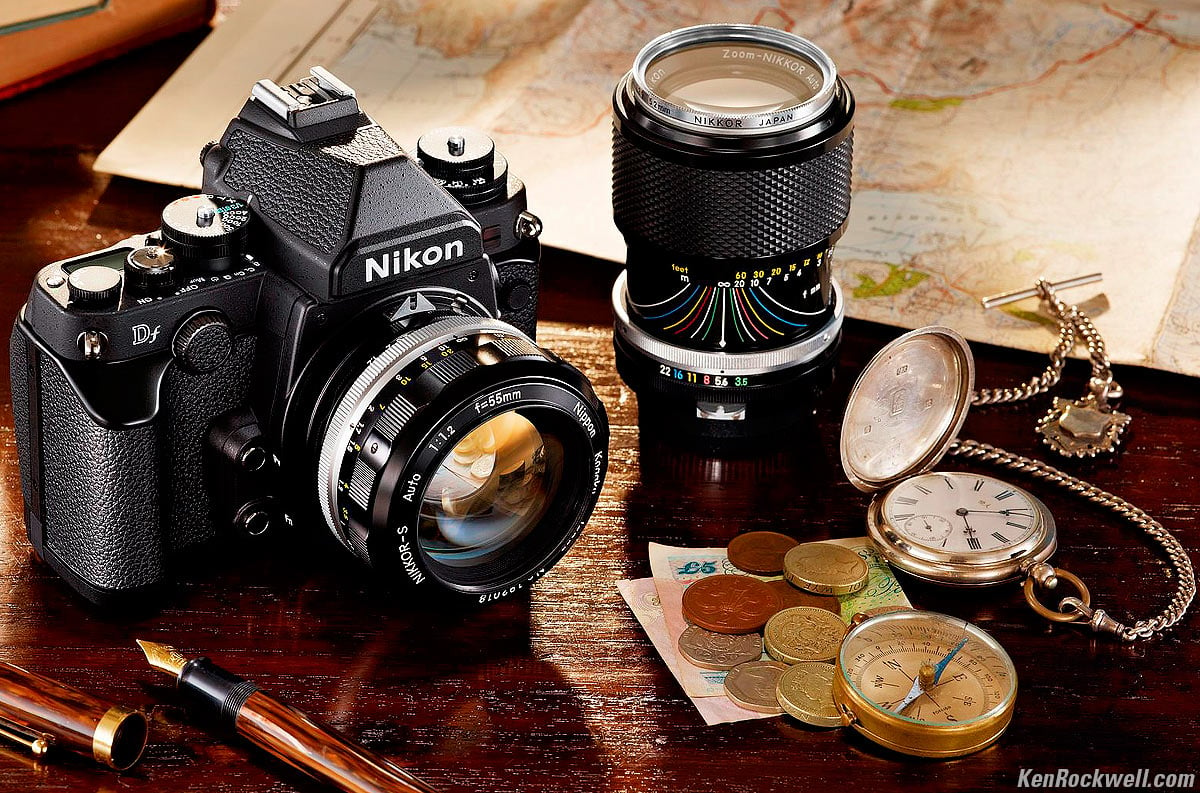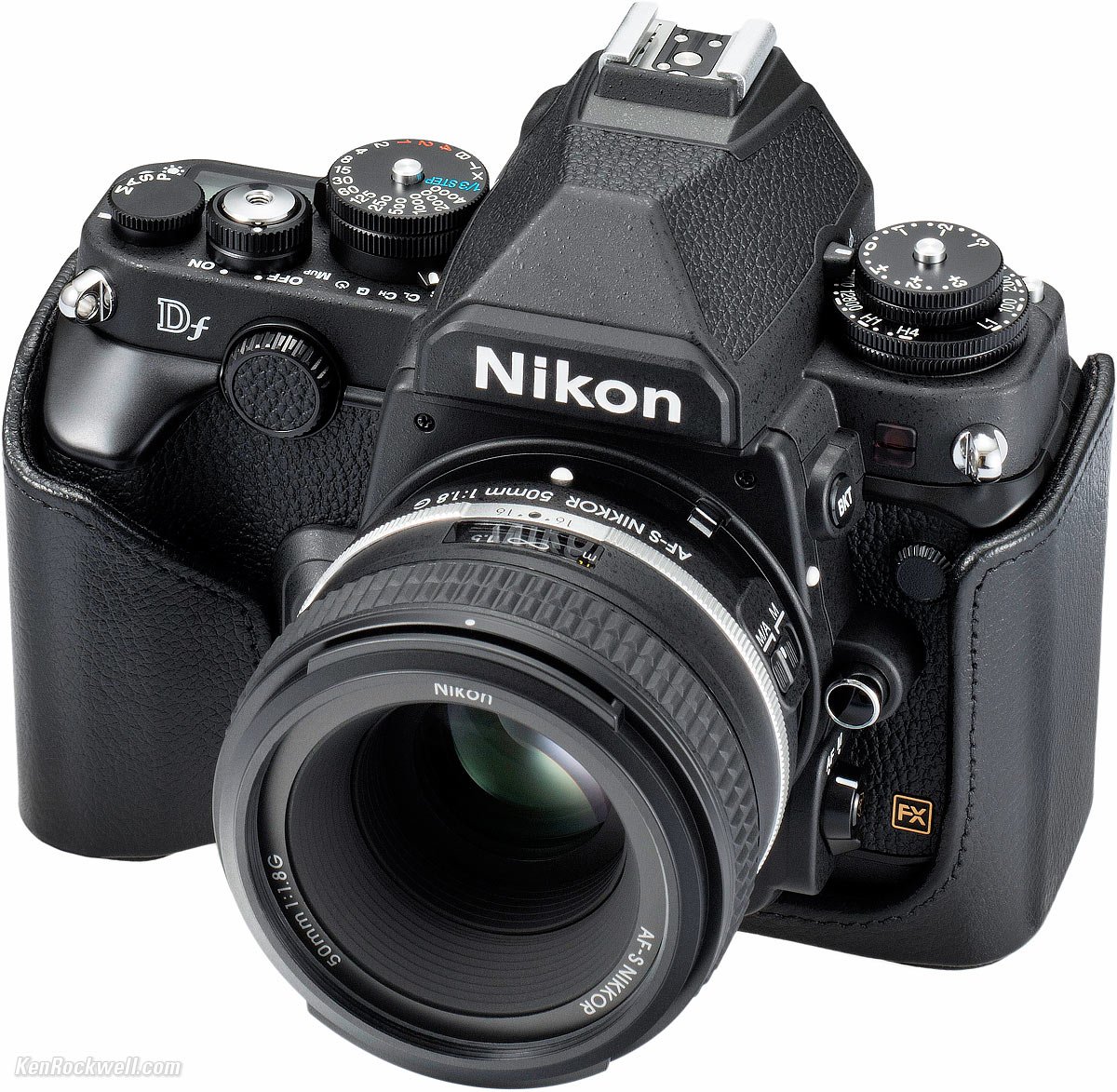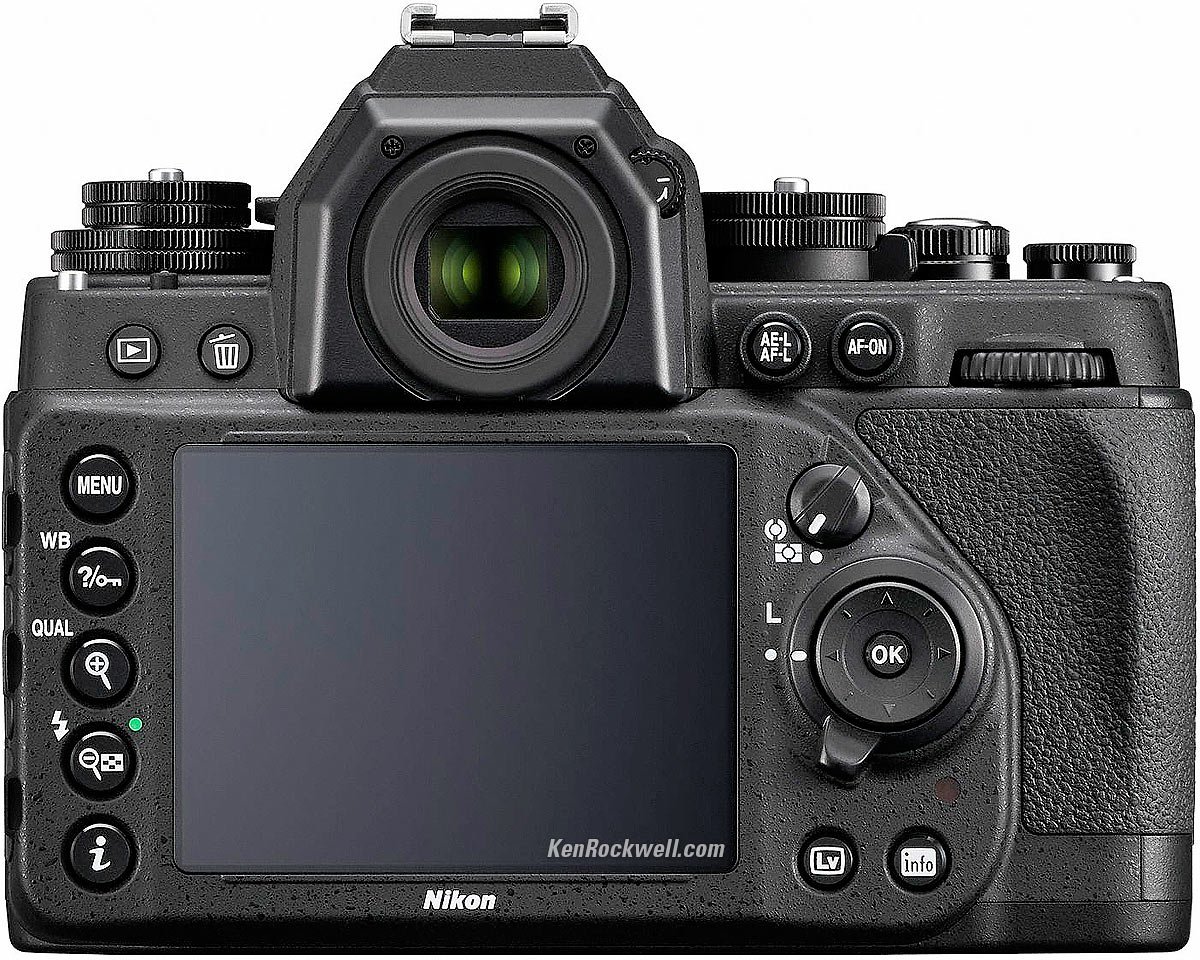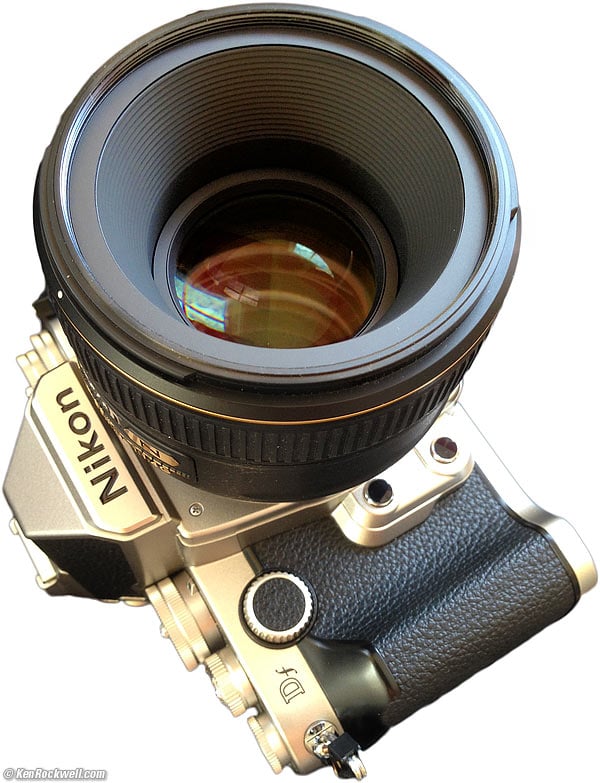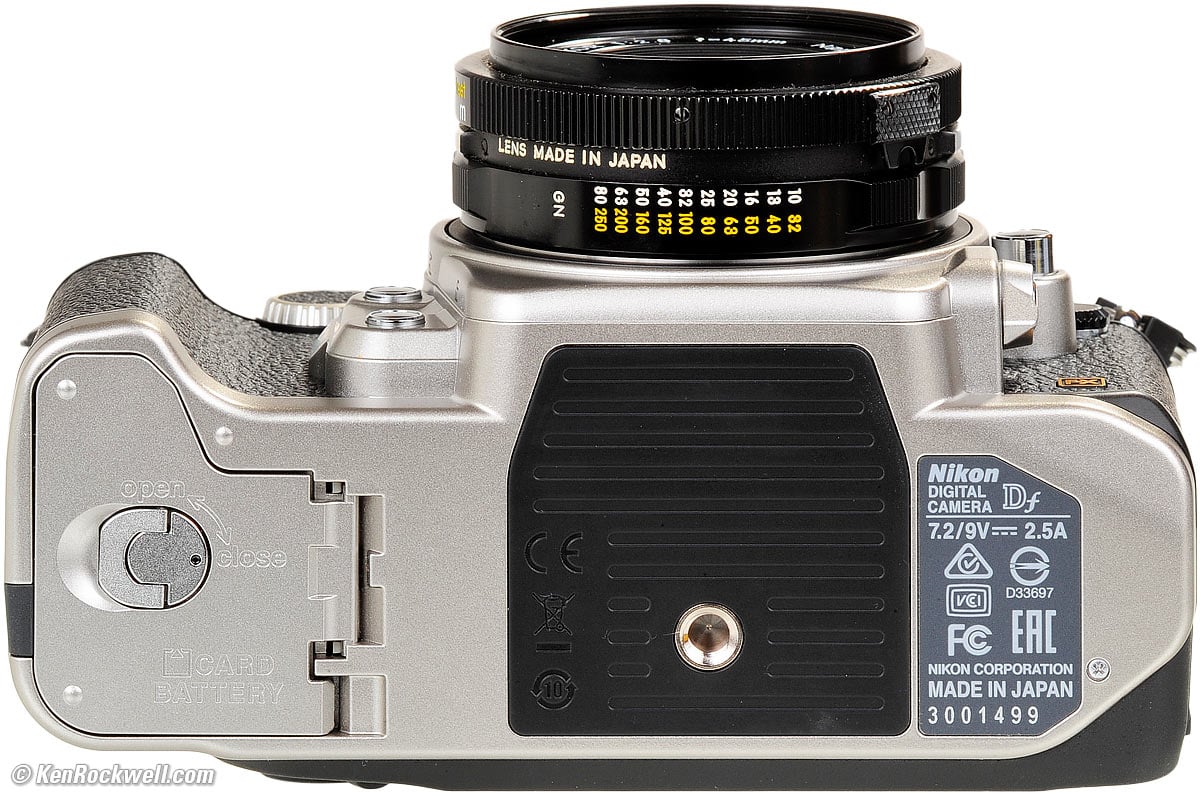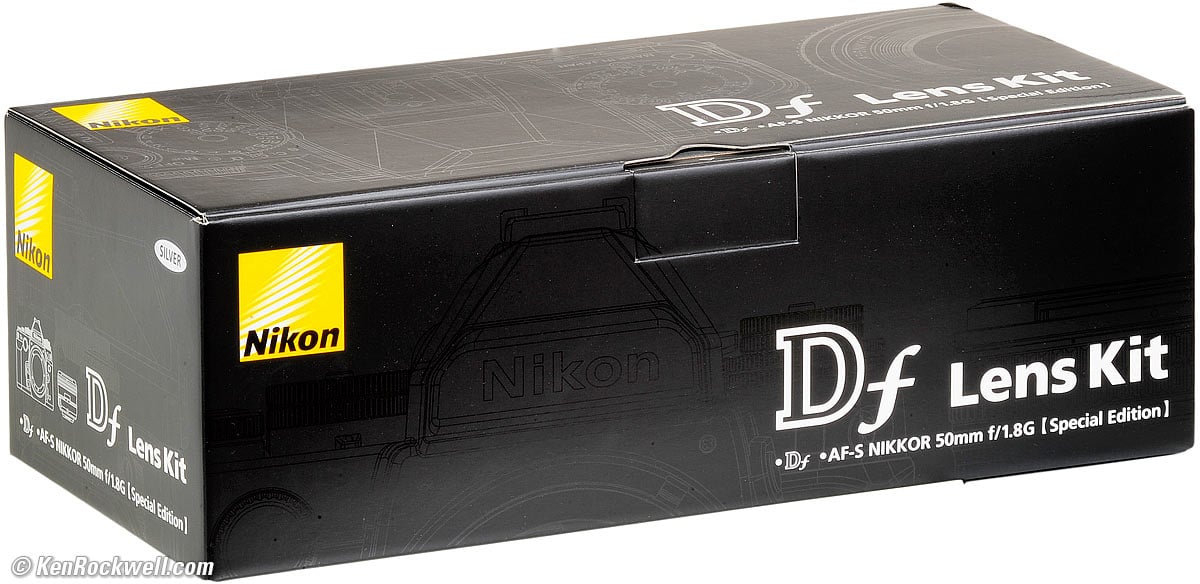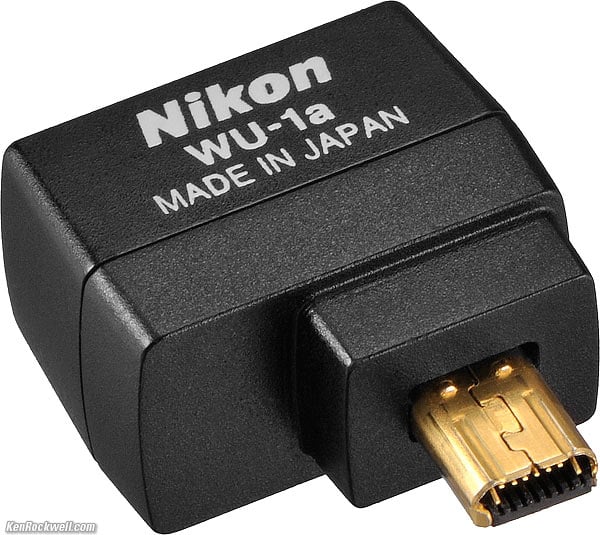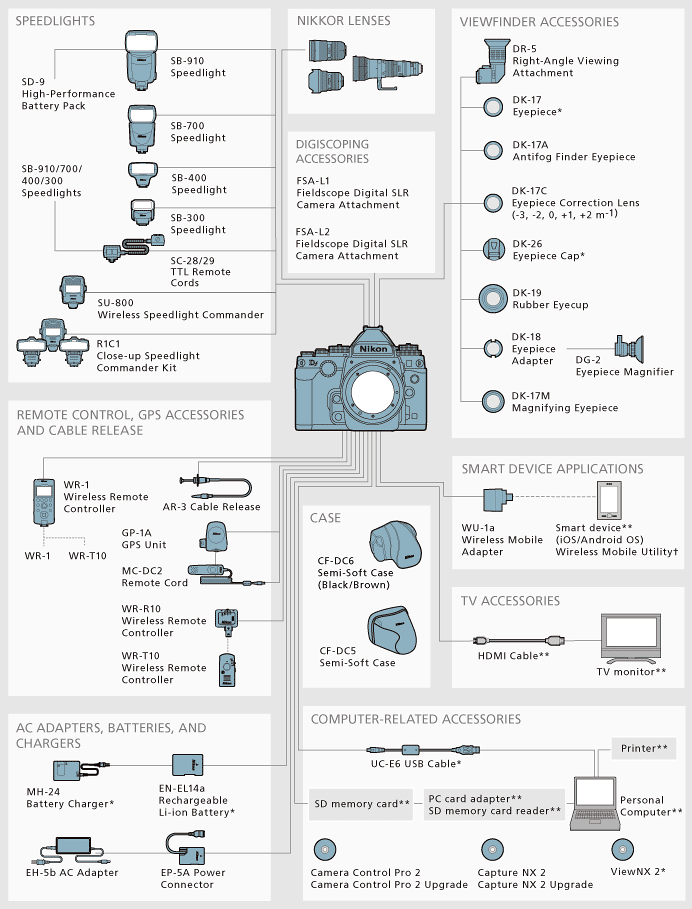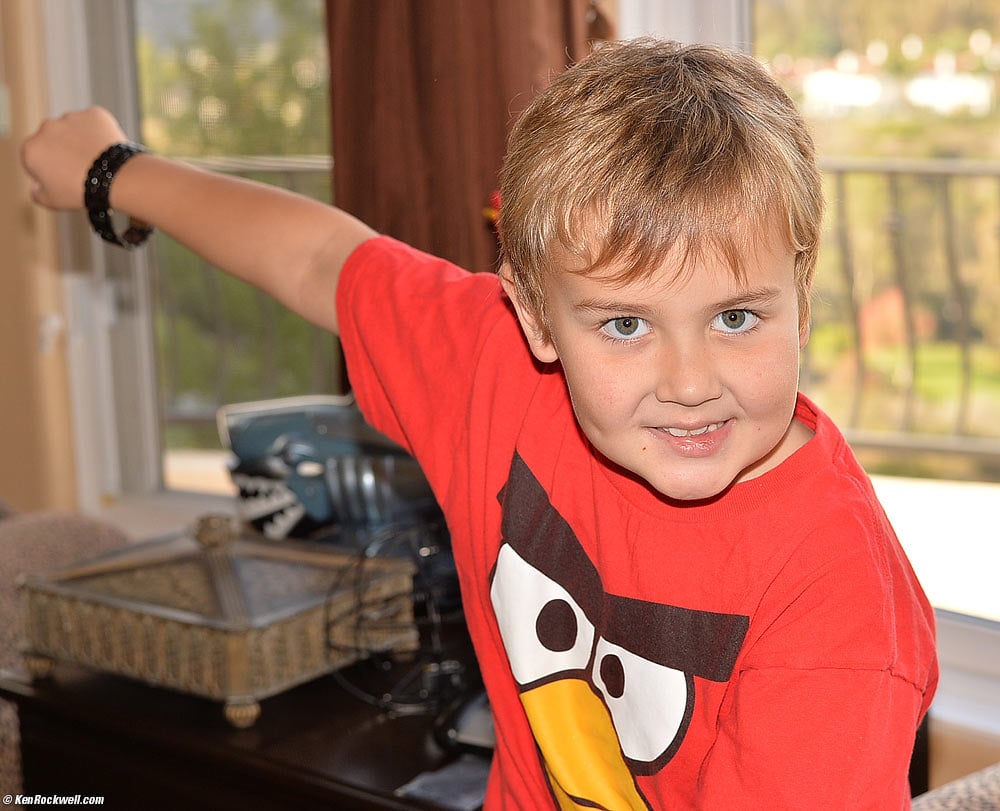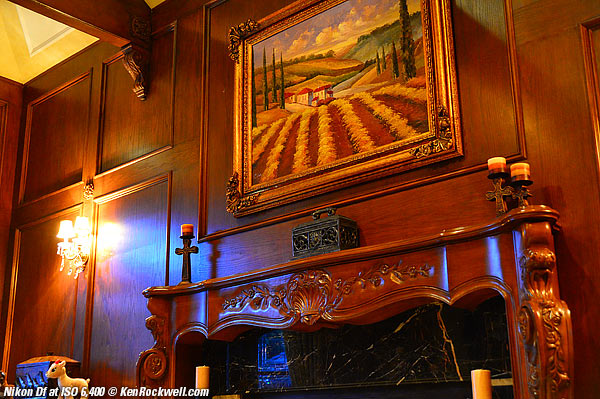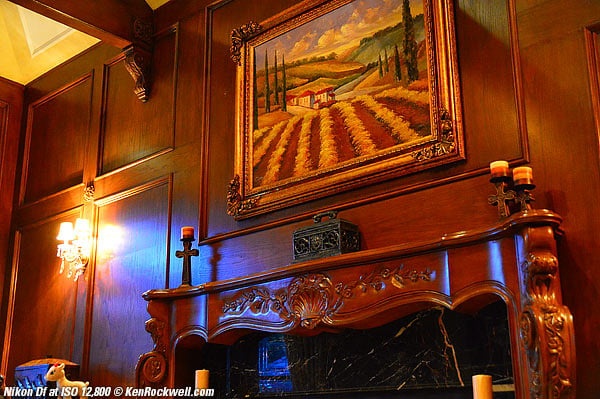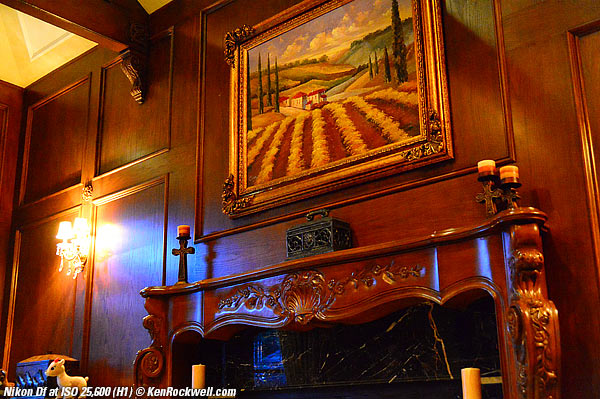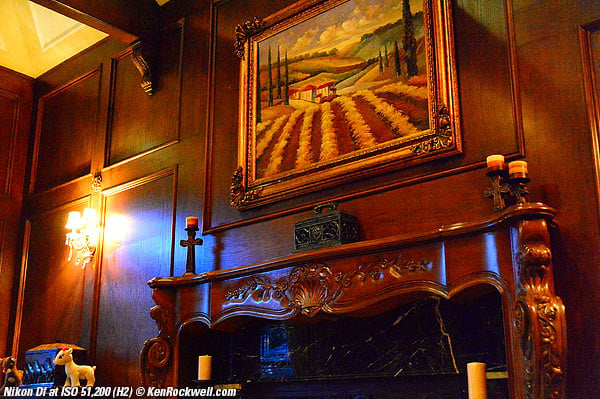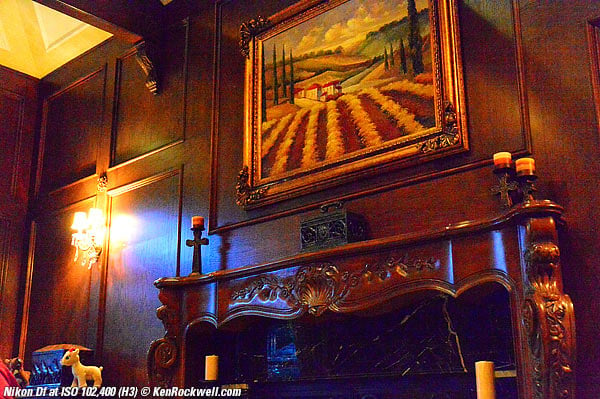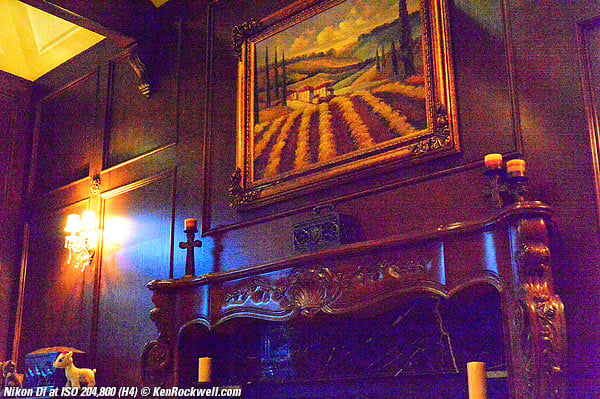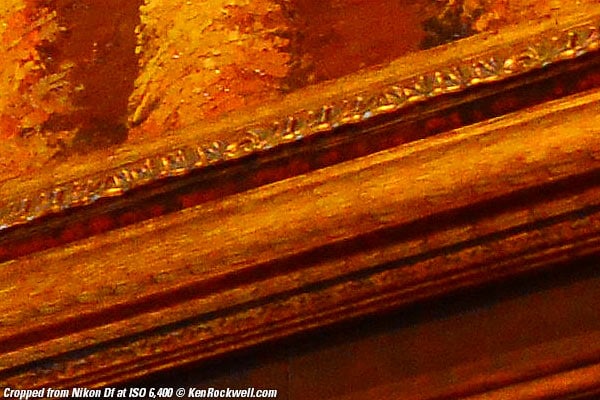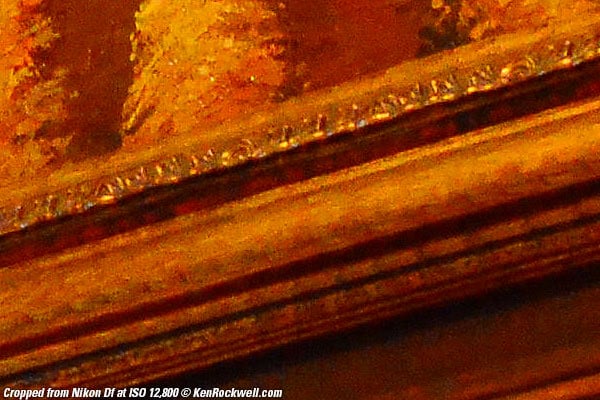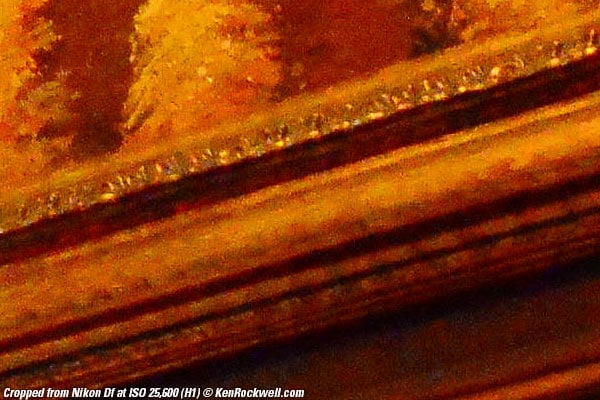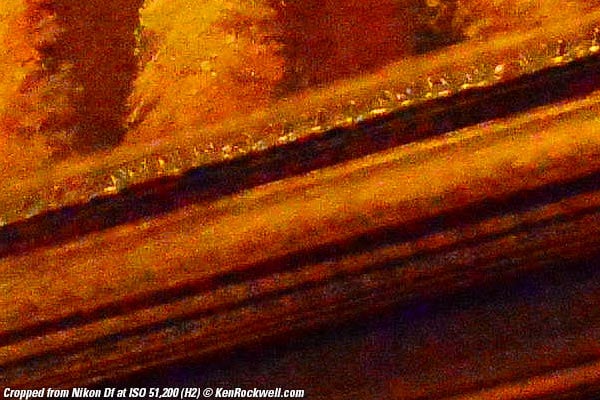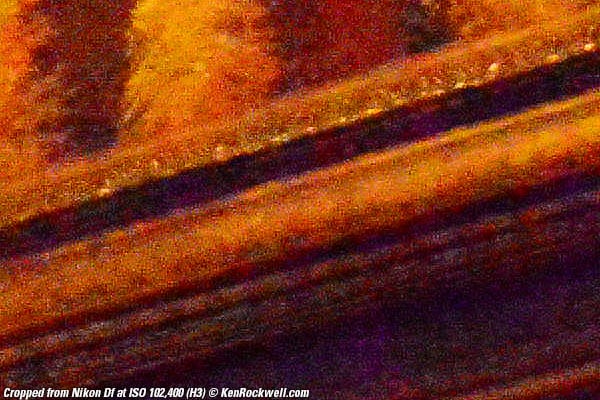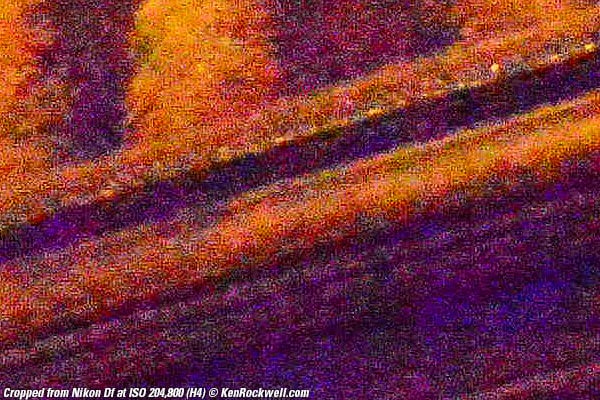Home Donate New Search Gallery Reviews How-To Books Links Workshops About Contact
Nikon Df
16 MP FX, 5.5 FPS, ISO 204,800
© 2013 KenRockwell.com. All rights reserved.
Introduction Lenses Missing Specifications Accessories
Performance Compared Usage Recommendations More
Nikon Df (26.7 oz./757g with battery and card) and 1970 Nikon GN Auto NIKKOR 45mm f/2.8. enlarge.
2021 Update: Sells for about $1,400 used if you know How to Win at eBay. The rest of this page is from 2013:
December 2013 More Nikon Reviews Nikon Lenses All Reviews
Nikon FM3a (2001-2006)
Nikon FE2 (1983-1987)
Nikon FE (1978-1983)
Nikon EL2 (1977-1978)
Nikon EL (1972-1977)
Top, Nikon Df and 1970 Nikon GN Auto NIKKOR 45mm f/2.8. enlarge.
Back, Nikon Df. enlarge.
Sample Image Files (more throughout the review)
Palm, 06 December 2013. Nikon Df, Nikon 58mm f/1.4 G, f/8 at 1/125 at ISO 100, Athentech Perfectly Clear. The tree is a living thing, it's not flat so most of it isn't in focus. Full-resolution.
Circle-K at f/1.4, 06 December 2013. Nikon Df, Nikon 58mm f/1.4 G, f/1.4 at 1/60 at ISO 250. Full-resolution.
GL550 Headlight, 06 December 2013. Nikon Df, f/13 at 1/200 at ISO 100. Full-resolution.
ISO 2,800: Ryan and the plasma ball, 10 December 2013. Nikon Df, Nikon 58mm f/1.4G, f/1.4 at 1/125 at Auto ISO 2,800, Athentech Perfectly Clear. bigger.
ISO 4,500: Night Fog, 12 December 2013. Nikon Df, Nikon 50mm f/1.4G, f/1.4 at 1/50 at Auto ISO 4,500, no stinking tripod. bigger or © camera-original file.
ISO 12,800: Katie plays follow the leader. cropped from Nikon Df, Nikon 50mm f/1.4G, f/1.4 at 1/125 at Auto ISO 12,800, Athentech Perfectly Clear. more full-resolution high ISO samples under performance. © camera-original file.
Introduction top
Introduction Lenses Missing Specifications Accessories
Performance Compared Usage Recommendations More
The Nikon Df is Nikon's lightest full-frame digital camera, and it's all metal. The Df a real metal camera with real metal dials instead of the plastic turds that ordinary people have come to accept as cameras. The Nikon Df is a tight, precise and lightweight little masterpiece. It's small, light, tough, and also rather quiet.
The Nikon Df packs the same professional sensor as Nikon's top-of-the-line D4. 16MP is better for pro use because files transfer and process much faster than the bloated 24MP and 36MP images from consumer cameras.
The Nikon Df is the most revolutionary Nikon since the Nikon F4 of 1986. The Df is more different from every other DSLR than any other DSLR, ever. Even the world's first practical DSLR, the Nikon D1 wasn't revolutionary; it was simply evolutionary. Only the D1's price was revolutionary, not the camera. In the Df, we have the world's first original DSLR that isn't simply a regurgitation of a current 35mm SLR, as the D1 was a digital adaptation of the Nikon F5 and the D2 was a version of the Nikon F6. The Df is actually a reissue of the Nikon FE of 1978, which is unheard of in the digital world.
The Nikon Df is a special camera for the experienced photographer who knows what he wants. If you're a casual buyer who selects a camera based on features, price, specifications and test reports, get a Nikon D610 instead for less money. The Df is a camera for those who appreciate magic; if you don't understand the importance of magic, you're probably not a very good photographer and certainly will never understand the raison d'être of the Df. Yes, the D610 costs less and does more — but who wants to shoot a plastic camera? I want to love my camera, not just look forward to when I throw it away in favor of whatever comes to replace it.
If you're a seasoned shooter who knows what you love, you'll love the Df. The Df is tight, fast and sharp.
What impresses me most about the images that come from my Df is how they seem to have more Pop! than images from lesser cameras, probably due to the Df's great low-light sensitivity and high signal-to-noise ratio.
For the first time in digital history, we have a Nikon DSLR built like a real camera, with engraved and knurled solid metal dials, alloy top, rear and bottom plates, and it takes a real cable release. It's a real camera, not a black plastic dog plop like everything else.
The design is masterful: we have solid metal dials for everything, and we also have two electronic command dials just like other DSLRs. Any user may use any of these dials any way he pleases. Bravo!
It's also smaller and lighter than any Nikon FX DSLR. In fact, it weighs the same as the plastic DX D7100 and D7000!
It comes in chrome or black. The chrome isn't really chrome, it's a marvelous light champagne or fake titanium color.
Left, Nikon Df and 1970 Nikon GN Auto NIKKOR 45mm f/2.8. enlarge.
Added from the FE
Professional black finish is no extra charge over chrome. Back in the day, black cameras sold for $25 more than chrome.
Both Time and Bulb settings on the shutter dial
Integral motor drive.
ASA and Exposure Compensation dials are separate, not the same dial with two sneaky scales.
Program and Shutter priority exposure modes, with a separate mode selector dial.
Electronic level, also visible in finder.
3D Color Matrix Meter.
Autofocus.
5.9 oz. (166g) of extra weight (each camera with battery and recording medium).
Added from the D610
Tougher build and less size and weight.
A real cable release socket.
PC sync terminal.
AF ON button.
5 frame bracketing (not just 3 like D610).
Uncompressed NEF option.
Lens Compatibility top
Introduction Lenses Missing Specifications Accessories
Performance Compared Usage Recommendations More
Notice the flipping AI coupling lever and traditional AF motor. enlarge.
Of course Df works perfectly with every AF lens made since 1987, AF, AF-I, AF-D and AF-S.
With a built-in AF motor and an aperture feeler for manual-focus lenses, it works great with every Nikon auto- or manual-focus lens made since 1977!
It also works great with AI and AI-S manual-focus lenses, and if you update the really old ones to AI, all Nikon's SLR lenses from as far back as 1959 work just fine with color matrix metering and aperture-priority auto exposure and full EXIF data.
But wait — there's more! Nikon retained the original Nikon FE's ability to flip-up the AI aperture coupling lever, so for a first for any unmodified Nikon DSLR, we can flip the lever out of the way and mount our original Nikon F Mount lenses all the way back to 1959!
The only gotcha with unmodified Nikon F mount lenses that were made from 1959-1976 is that there is no way to couple the aperture into the camera; there is no original top-center feeler rod to couple manually to the lens' prong. With F mount lenses, you have to set the camera via the camera command dial to the same f/stop you set on your lens. More practically, I'll use stop-down metering (and AE lock if in AE) with F Mount lenses, exactly as we do with the Nikon FE.
Nikon has gone so far to show us an image with the Df and two F-Mount lenses, the 55mm f/1.2 (a good lens) and the classic Nikon 43-86mm f/3.5 (1963-1976), which is actually Nikon's poorest-performing lens of all time; a lens so optically awful that it single-handedly gave all zoom lenses a bad reputation for the next two or three decades. (Nikon made a newer version of the 43-86mm f/3.5 from 1975-1982 which is very good. The bad lens as shown here has its identity on an engraved ring inside the filter mount, while the newer good lens has its identity engraved outside the filter mount.) Nikon even went so far as to show a silver-ring filter on the 43-86; Nikon knows its heritage.
Nikon Df, 55mm f/1.2, 43-86/3.5, fountain pen, compass and pocket watch. enlarge.
More at Nikon Lens Compatibility and Recommendations and Nikon FX Lens Recommendations
Colors
Comes in black, too:
Black Nikon Df and 50mm f/1.8 Special Edition in the bottom half of a CF-DC6 case. enlarge.
Nikon Df in professional black. enlarge.
Not exactly standard, but collectors have already sent Dfs out for customization. Here's one in gold:
Nikon 58mm f/1.4 G on a gold Nikon Df from a private collection. A camera as special as this has people doing crazy things like this to them.
What's Missing top
Introduction Lenses Missing Specifications Accessories
Performance Compared Usage Recommendations More
No one has made a perfect camera after almost almost 200 years of photography. Here's what's missing:
No Built-In Flash
The FE never had one either; built-in flashes are for point and shoots like the Nikon 35Ti. I use my tiny SB-400 which is much better than any built-in.
No U1, U2 and U3 Presets
We're stuck with the same stupid Menu Banks from 2007 instead:
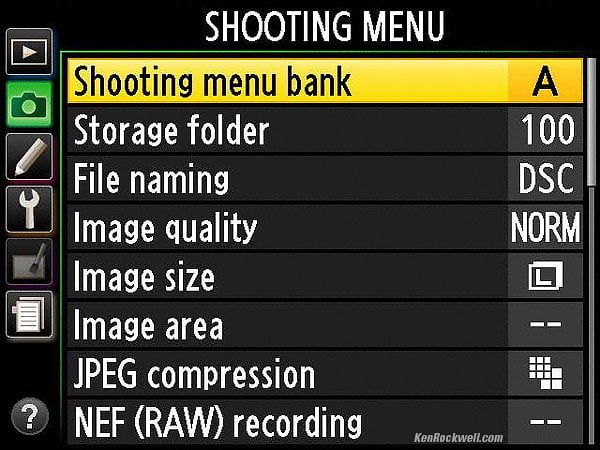
Oh no: Menu Banks, 2007's worst idea returns.
The FE never had any of this and didn't need it.
No second card slot
Only one SD card slot, making the Df a dangerous choice for professional work because it can't shoot backed-up to two cards at once. One error on one card (or a photographer goof), and you could lose the whole job. Sure, shoot a serious job on the Df, but one false move and it could all be gone forever. Feeling lucky?
Shooting on o ne-card-only makes backup far more difficult; you can't safely format the card until you've transferred the files to your computer AND backed them up to a second physical location. With dual cards, once you've downloaded a card to your computer, you can format it and safely go about your next business with everything on both the second card in your camera as well as in your computer — two copies in different physical locations — just not possible with the one-slot Nikon Df.
No easy way to turn AUTO ISO on and off
Bless Nikon's real ISO dial, but they forgot the AUTO position.
You have to stop and go into a menu to turn Auto ISO on and off in the Df, while on most other Nikon DSLRs all you have to do is hold the ISO button and flick the front dial. Whoops!
No Battery Percentage indication
It only has a battery gauge icon, never a percentage indication.
No full stop settings option
Only half or third stops.
No AUTO or 8 seconds positions on shutter dial
But there is a P S A M mode selector dial on the top, right next to the shutter dial, and the electronic dial will get you to 30 seconds.
Nikon could have made the mode selector concentric with the shutter dial as they did on the FA, but put the advance mode switch there instead.
No M90 position on shutter dial
The FE has a batteryless manual shutter position. It could fire at 1/90 or bulb without batteries.
I won't fault Nikon here; even if the shutter of the Df would fire without batteries, it wouldn't do us much good if the camera couldn't record what came off its sensor.
Only 30 second maximum AUTO exposure time
The FE makes accurate automatic exposures out to many minutes, while the Df and D4 only go to 30 seconds.
No worries; the Df and D4 go to higher ASAs (a.k.a. ISOs) than film for the FE, so we don't have to wait around as long for it to expose in the dark.
Smaller 0.70x versus 0.86x magnification finder
The Df is the same as other DSLRs, while the FE has a bigger, better finder than any DSLR or modern LEICA.
No lock on the AI coupling tit
The FE has a lock so that its AI coupling tit won't get knocked by accident, while the same tit on the Df moves at any time. If you knock it, the Df will give you a meaningless error message when using most AF-D lenses and won't shoot until you know to move it back.
No Interchangeable Focus Screens
No Full-Frame Autofocus
No DSLR has full-frame AF; they all crowd their sensors into the middle of the finder. Exactly like the D610 and similar FX cameras, all the AF areas are in the middle of the frame.
You can focus anywhere via Live View, but you can't do that through the viewfinder because the Df, as do all DSLRs, has:
No Electronic Viewfinder
No other DSLR has one either, but ever since the Fuji X100, I'm waiting for a combined SLR optical and electronic finder that lets me see what I just shot, as well as live view, through the finder window if I want it. (Sony makes mirrorless cameras erroneously marketed as DSLRs; they aren't.)
The FE and D4 don't have one either, but the first top-tier maker who does is going to get a gold star from me.
No AF Assist Light
The FE and D4 don't have one either, but your shoe-mount flash may.
Without an AF assist light, the Df simply gives up and cannot autofocus if the light is too dark.
No AF-A mode
There is AF-S and AF-C, but curiously the AF-A (auto select) mode is missing.
No 5:4 crop mode, but does shoot DX
I may be the only one on Earth who uses the 5:4 crop in my other FX cameras, but especially for vertical shots, I love having my Function button set to let me crop off those unused ends so I don't have to crop them later.
No Sound, Movies or Video
Good riddance. Not on the FE either. Use your iPhone; it focuses better than a DSLR.
No LCD Auto Brightness Control
Since the Auto Brightness Control of the D800 doesn't work well enough to use, I wouldn't use this even if the Df had it.
If you want Auto Brightness control that works well, you need the Canon 5D Mark III.
15mm, not 21mm, Eyepoint
So?
No locking power switch
This is also missing on most Nikon SLRs other than the F5 and F4, but the good news is that the Df's different power switch is much less likely to get knocked than on any other Nikon DSLR.
Specifications top
Introduction Lenses Missing Specifications Accessories
Performance Compared Usage Recommendations More
Sensor
Nikon Df Sensor. enlarge.
16 MP CMOS.
14-bit linear ADC, 16-bit processing.
Ultrasonic cleaner.
FX (23.9 x 36 mm)
4,928 x 3,280 pixels (16 MP) native LARGE.
3,696 x 2,456 (9 MP) MEDIUM.
2,464 x 1,640 (4 MP) SMALL.
DX crop (16 x 24mm)
3,200 x 2,128 pixels (7 MP) LARGE.
2,400 x 1,592 (4 MP) MEDIUM.
1,600 x 1,064 (1.6 MP) SMALL.
No 5:4 cropped mode.
ISO
Auto or ISO 100 ~ 12,800 in the usual electronic modes, ISO 50 ~ 204,000 if you invoke the L- or H+ settings.
ISO 50 ~ 204,000 directly settable on the top ISO dial.
Photo File Formats
JPG: FINE, NORMAL and BASIC, size or quality priority.
NEF (raw) 12- or 14-bit, uncompressed, lossless or lossy compressed.
NEF + JPG.
Autofocus
39 points, mostly all crammed into the center of the FX image.
LV -1 to +19.
Single-point AF, 9-, 21- or 39-point dynamic-area AF, 3D-tracking and/or auto-area AF.
Multi-CAM4800 sensor array, which has the same size and sensor locations as the DX-sized CAM4800DX AF sensor of the D7000.
AF Fine-Tuning.
No AF assist light — just like the D4 and FE.
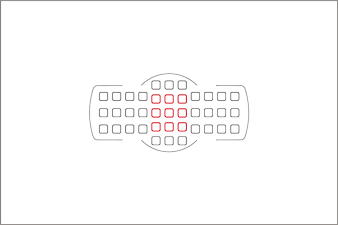
39 AF points. These all work with lenses as slow as f/5.6. The 9 red ones are cross-type, working with lenses and teleconverter combinations as slow as f/7.1.
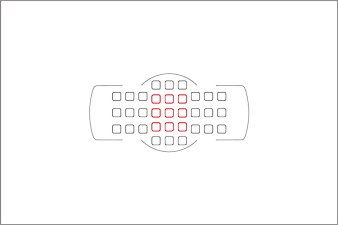
These 33 AF points work with lenses as slow as f/7.1. The red ones are cross-type with lenses as slow as f/7.1.
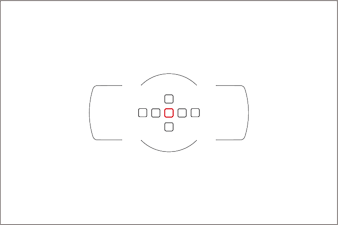
These 7 AF points work with lenses as slow f/8. The red one is the only cross-type sensor that works with lenses as slow as f/8.
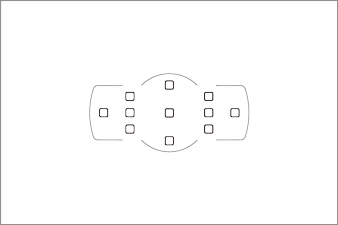
Settable 11-AF point option for ease of selection.
Finder
Glass pentaprism.
100% coverage FX. (97% coverage DX.)
0.7x magnification with 50mm lens.
15mm eyepoint.
Live View
Up to about 19x magnification for focus checking.
Exposure Metering
2,016-pixel RGB 3D color Matrix meter.
Center weighted: 75% of sensitivity is inside 12mm circle. (also 8mm, 15mm or 20mm circle settable in menus.)
Spot: 4mm diameter around selected AF point (1.5% of total area).
0 to 20 LV (2 to 20 LV in spot).
±3 stop compensation on dedicated dial.
2 to 5 frames bracketing in steps of 1/3, 2/3, 1, 2 or 3 stops.
AE Lock button.
2,016 pixel matrix i-TTL for flash, as well as spot flash metering.
Flash
Sync speed 1/200 or 1/250.
Hot Shoe (ISO 518) with lock.
PC (Prontor-Compur, ISO 519) flash terminal with thread lock.
i-TTL exposure control.
Front, rear, slow sync with or without red-eye reduction, and Auto FP High-Speed Sync options.
-3 to +1 stop flash exposure compensation.
No built-in flash, but SB-910, SB-900, SB-800 or SB-700 can work as a commander for wireless flash.
Shutter
Nikon Df Shutter. bigger.
Tested to 150,000 cycles.
1/4,000 ~ 30 seconds, Bulb and Time. (only to 4 seconds from shutter speed dial; use the electronic Command dial for longer speeds.)
Frame Rates
5.5 FPS maximum in Continuous High.
Continuous Low settable to 1, 2, 3, 4 or 5 FPS.
Quiet mode.
Mirror-up mode.
X = 1/200.
The X setting is 1/200 and Nikon also says flash works at the 1/250 setting.
If the camera syncs at 1/250, then why would the X setting be only 1/200, or does the camera retard to 1/200 with flash when 1/250 is set?
Nikon doesn't clarify what's really going on. No big deal, I never bicker about 1/3 of a stop between friends.
Self Timer
2, 5, 10 or 20 seconds.
1 to 9 frames at each instance, with 1/2, 1, 2 or 3 seconds between them.
Remote Releases
Any standard cable release, like Nikon's classical AR-3.
MC-DC2 remote control ($25).
No wireless control; requires outboard WR-R10 and WR-1 system.
Rear LCD
3.2," 921,000 dots.
170º viewing.
It seems like the same thing as on the $6,000 D4.
Storage
SD card slot.
SDHC, SDXC and/or UHS-I.
Data & A/V Connections
USB 2.0.
Type C mini-pin HDMI connector.
Mechanics
Top, back and bottom covers: Magnesium alloy.
Partially weather-sealed to the same extent as the D800.
Power
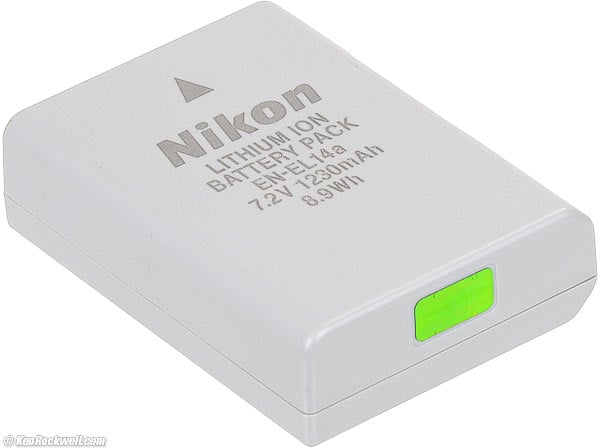
EN-EL14a battery.
EN-EL14a battery, same as D5300 and D5200.
Rated 1,400 shots, which is 50% more than the D610, but remember that the Df has no built-in flash.
Nikon folding-plug MH-24 charger. enlarge.
The MH-24 charger has a folding plug, as a charger should. It's much better than the clumsy abortions like the MH-25 we use with the D800 and D610 etc.
Optional AC adapter EH-5B ($80) and EP-5A power connector ($35).
Bottom, Nikon Df and 1970 Nikon GN Auto NIKKOR 45mm f/2.8. bigger.
Size
5.65 x 4.33 x 2.62 inches WHD.
143.5 x 110.0 x 66.5 millimeters WHD.
Weight
26.695 oz. (756.9g) actual measured weight with card and battery.
Nikon rates it as 27.0 oz. (765g) with battery and SD card.
Nikon rates it as 25.0 oz. (710g) stripped naked without battery, card, strap, monitor cover or lens.
Quality
Made in Japan.
Included
Nikon Df kit box. The box has a varnish (gloss) layer with graphics of the camera's dials that looks stunning in person. bigger.
Nikon Df body in classic chrome or professional black.
(Nikon 50mm f/1.8 Special Edition if ordered as part of a kit.)
MH-24 charger.
DK-26 Eyepiece Cap — with string!
UC-E6 USB Cable
AN-DC9 Camera Strap
BF-1B Body Cap
BS-1 Hot Shoe Cover.
Nikon ViewNX 2 software CD-ROM.
Price (USA)
June 2021
Sells for about $1,400 used if you know How to Win at eBay. The rest of this page is from 2013.
December 2013
$2,747, body only, also in professional black for no extra charge.
$2,997, kit as shown with 50mm f/1.8 SE; also in black at no extra charge.
$2,747, body only, also in professional black for no extra charge.
$2,997, kit as shown with 50mm f/1.8 SE; also in black at no extra charge.
Chrome body at Adorama, the black body at Adorama, the chrome kit with 50mm lens at Adorama, the black kit with lens at Adorama or any of these at Amazon.
Announced
Tuesday, 05 November 2013.
(Actually 10:59:32 PM Monday night New York City time, 04 November 2013.)
Promised
Late November 2013.
Right side, Nikon Df and 1970 Nikon GN Auto NIKKOR 45mm f/2.8. bigger.
Optional Accessories top
Introduction Lenses Missing Specifications Accessories
Performance Compared Usage Recommendations More
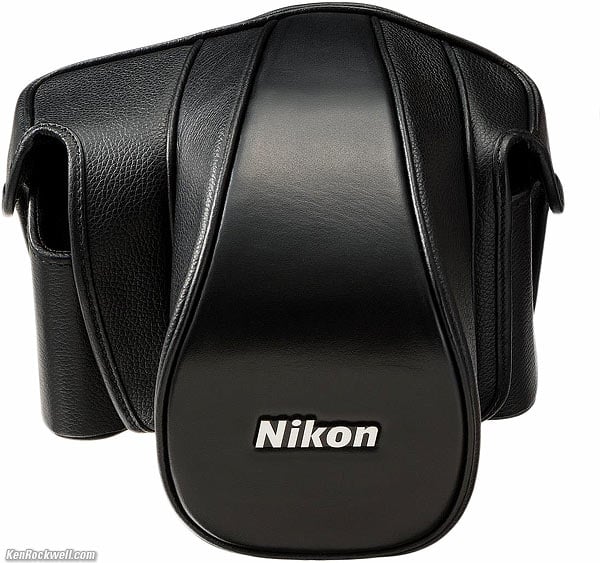
Nikon CF-DC6 case, black.

Nikon CF-DC6 case, brown.
There's also a more generic CF-DC5 case, that's on sale for $66 as I write this.
GP-1A GPS
GP-1A GPS module ($279).
WU-1a Wireless Mobile Adapter
The $49 WU-1a Wireless Mobile Adapter plugs into the Df's USB connector and then hangs out the side.
It allows two-way communication between the Df and an iPhone or iPad or other Apple iDevice, or the Android. With an appropriate app (Nikon Wireless Mobile Adapter Utility), you can control the Df remotely and see what it's doing via Live View on your iPod Touch or etc.
Once shot, the images also just fly into your iPad or whatever, from which you can send them out or do what you want with them — but hey, if you have an iDevice, isn't it easier just to use its camera in the first place?
Accessory Chart
Nikon Df Accessories. bigger.
Performance top
Introduction Lenses Missing Specifications Accessories
Performance Compared Usage Recommendations More
Overall Autofocus Ergonomics Finder Flash Image Quality
LCD Mechanics Meter and Exposure Power and Battery
Overall performance top
The Df is a sharp, solid performer. It's autofocus doesn't work in the dark, but is sure feels good.
Autofocus performance top
Autofocus the Df's weakest point.
The Df has no AF illuminator, and in very dim light, it simply won't autofocus. It will rack the lens in and out once and then give up.
You'll have to improve the light, or use a flash with an AF illuminator, or hope to find something else well lit at the same distance as your subject. My Canon 5D Mark III is much better, focusing in nearly pitch black just fine — but not with my Df.
While there are plenty of AF sensors, they are all in the center of the image. There are no AF sensors close to the corners, top, bottom or left or right sides of the frame.
Curiously the AF-A (auto select) mode is missing. There is the usual AF-S and AF-C modes.
Manual focus
Manual focus is pretty good.
There is a three-segment > o < electronic indicator in the finder.
The finder screen is better than most DSLRs. While most DSLRs have screens that only show defocus and depth of field for lenses of f/2.5 and slower, the screen in the Df works up to about f/ 2.2. No big deal, but it is a little bit better for use with fast manual lenses than other DSLRs.
Ergonomics performance top
The Df is all about ergonomics. A nice touch is Nikon using the real AI logo in the menu system where you set your non-CPU lens data, and tell it if your lens is AI or not.
Oddly, its biggest flaws are that many adjustments that ought to lock don't and those that shouldn't, do.
Really good is that its card door is on the bottom, so pulling the camera from a bag doesn't just open a card door as it does on most other DSLRs.
There are no camera presets. There are idiotic Menu Banks, but they can't lock and they don't recall many settings, like AF settings, making it much more difficult to reset the Df to and from different kinds of shooting.
Strap Lugs
The lugs are on the front of the camera where they belong so that the camera doesn't flop forwards with a lens attached.
This is much better than cameras like the LEICA M typ 240 that put them closer to the rear, which often leads to those cameras flopping forwards with a lens attached.
Front Dial
The front dial is metal. It's copied from the Contax G2 which copied it from 1930s Contaxes, and which were copied by Nikon in their 1940s-1960s rangefinder cameras.
It's more for looks than function; it's more difficult to turn than a common Nikon front dial.
Front AI coupling lever
This is much flimsier than on the Nikon FE. It also doesn't lock, so if you get weird warnings with a new lens mounted be sure it's flipped forward to its normal (engaged) position.
Exposure Compensation Dial
The exposure compensation dial looks great, but it's the Df's weakest point if you actually try to use it.
Instead of a properly designed free-spinning compensation dial with a deeper detent at 0 as on the Contax G2, the Nikon dial has the same detents for each setting which makes it impossible to set this dial by feel.
Worse, the Nikon Df dial has a lock for every setting. Therefore, setting compensation on the Nikon Df is an abomination requiring two hands and looking at the darned dial.
The ordinary +/- button of other Nikon DSLRs is much better.
ISO Dial
Nice, but since Nikon forgot the A position, I have to use menus to turn AUTO on and off, which I can do without taking my eye from the finder on other current Nikon DSLRs.
This ISO dial locks at each and every setting, again demanding a second hand to set what we can set with just one hand on many other cameras — oops!
Therefore, this dial actually handles worse than other DSLRs.
Shutter Dial
The shutter dial is another botch: it's in the wrong place and the wrong size with too sharp an edge for easy or comfortable use as you shoot. Nikon should have looked to the LEICA M3 mit LEICAMETER MR for how to do this so we could adjust it as we shoot. Nikon used to know this.
Clever is that you get back to using the dials by setting the 1/3 STEP position.
Bad is that it feels a bit wobbly, as if it's plastic underneath.
It clicks freely among most speeds. It will lock at the 1/3 STEP or T positions if you overshot the other settings. You will then need a second hand to unlock the dial and get back to your regular speeds. It locks at B, X and 1/3 STEP.
Advance Mode Lever
The advance mode lever (S, Cl, Ch, Q, timer and Mup) is excellent. It's easy to flick with my thumb by feel. Too bad the other dials of the Df aren't this well thought out.
Power Switch
The power switch rotates. It can be moved with an index finger as you're shooting.
It has no lock; it ought to lock unless lifted to turn.
Shutter Button
The shutter button is excellent. It pushes straight down. It's a solid hunk of metal, and feels more precise and has less wobble than the weak shutter button of the LEICA M typ 240.
It seems much less likely to be triggered by accident in a bag if the camera is left on.
The button is also threaded for a real cable release, the same as the LEICA M typ 240.
There isn't any shutter delay; the Df just shoots.
Mode (P, S, A and M) Dial
Nikon messed this one up, too.
It is always locked.
To release it it has to be lifted and turned at the same time, so the mode can't be changed unless you stop and use two hands!
Illuminator button
No news; it just works.
The illuminator is perfect: a medium cool-white glow. Nikon got this right.
Top LCD
The top LCD is clean, clear and simple.
It has just what I need to know without the endless baloney on lesser cameras.
Rear Buttons
The rear buttons are not illuminated.
They are clever and finally light the rear LCD automatically as we press them so we can set ISO, WB etc. without having to monkey around.
Rear "i" button
The rear "i" button replaces the Picture Controls button.
No worries, you can get to Picture Controls in one more click, or other things if you prefer.
Sadly, this button is on the wrong side of the camera and demands a second hand to set. The INFO button on the right can't be used to set anything — whoops!
Rear dial
The rear dial is the same excellent, hard rubbery one as other Nikon DSLRs.
Bottom Door
The plastic bottom door has a nice metal latch, but if you pull out your card and set the Df down with an open door, the door often pops off.
Finder performance top
The finder has a meter-mode icon. All the data is lit in green on black as usual.
It's not as clear as the original Nikon FE; like most finders with variable diopters it is made slightly less sharp due to these extra optics. No big deal; it's the same as other DSLRs, just smaller and less sharp than a real Nikon FE.
Flash performance top
These is no built-in flash.
Flash modes and exposure compensation are set with the bolt button on the back left.
Flash exposure with my SB-400 and SB-600 is exceptional. Flash exposure, especially for outdoor fill, is always perfect.
Here's how well indoor fill flash balances with outdoor daylight:
Ryan plays with Dada's $8 Lava Watch, 08 December 2013. Nikon Df with SB-600, Nikon 58mm f/1.4 G, f/5.6 at 1/125 at ISO 400. bigger.
And here's how well natural outdoor fill flash balances:

Katie at the park, 12 December 2013. cropped from Nikon Df, Nikon SB-400, Nikon 50mm f/1.4G, f/5 at 1/125 at Auto ISO 100, Athentech Perfectly Clear.
Ryan in the snow, 08 December 2013. Nikon Df, SB-600, Nikon 35-105mm AF-D at 105mm, f/6.3 at 1/160 at ISO 100, Athentech Perfectly Clear. bigger.
Image Quality, technical performance top
Resolution
With only 16 MP, resolution is inferior to most other cameras — but no one cares!
No big deal, I've sold 4 MP images to McDonald's in 2013 — for use on billboards. Only amateurs worry about pixel ratings today.
I usually shoot with my cameras set down to 6 MP, so this doesn't concern anyone who's on top of things.
Auto White Balance
AWB is usually excellent, and excellent indoors under tungsten light.
It usually looks bad under fluorescent, which is because life looks bad under fluorescent, too!
Auto ISO
Auto ISO is state of the art. It's easy to program it to do whatever you want, even with the ability to vary the focal-length-based automatically selected slowest shutter speed!
Canon can't come close.
HDR works, even hand-held in the dark. It auto-aligns, no stinking tripod needed.
I set it to "Natural" rendition, and it works subtly and smoothly to return detail that otherwise was washed-out or black.
Here is with and without:
Regular shot: Deer, 08 December 2013. Df, 35-105D at 40mm, f/3.5 at 1/40 at ISO 8,000. Camera-original © file.
In-Camera HDR, 08 December 2013. Df, 35-105D at 35mm, f/3.5 at 1/40 at ISO 6,400 (reported). Note how detail returned to the deer and how the background is also lighter. Camera-original © file.
The ISO 204,800 setting looks awful. It's only there as a marketing bullet point; don't use it.
Here are samples at ISO 6,400 through ISO 204,800. You may click any of them for the camera-original file.
And here are crops from the above images at 100%:
High ISO Analysis
As ISO goes up, the image starts to evaporate and be replaced by gray. All cameras do this.
In the complete images, notice how the image loses saturation, vibrancy and detail in the shadows as the ISO is increased. At its worst at ISO 204,800, the shadows are nothing but a smoky blue!
Looking at the cropped samples, which if they are 6" (15cm) on your screen would result in the entire image printing at 50 x 33" (125 x 85 cm), you'll see how fine details and textures are simply replaced with noise. Even cropped you can see how color and vibrancy simply fade away at stupid-high ISOs. This is because all digital cameras today use noise reduction to keep the noise low, which means that they smudge over all the details.
Since the Df uses the same sensor as the D4; my Nikon D4 Versus The World High ISO Comparison ought to be reasonably valid for the Df. They both look awful at ISO 204,800.
LCD, rear performance top
Far better than every other current FX Nikon, my Df's LCD is color accurate right out of the box, devoid of the sickening yellow-green emphasis of most other current Nikon FX cameras. Hallelujah!
My Canon 5D Mark III LCD is still much better, with good Auto brightness control and much bigger images because the Canon LCDs are the same shape (aspect ratio) as the pictures, while the Nikon LCDs have wasted space showing 3:2 images on their 4:3 LCDs.
Mechanics performance top
It's almost all metal, just like a real camera.
The top plate and pentaprism housing is metal. The clear sheet that covers the top LCD is glued-on plastic, just like the frame counter cover of the Nikon EL2.
The top dials, buttons and levers are all engraved metal.
The shutter dial is engraved and knurled metal, but feels a little mushy as if it's really plastic underneath. It's not as solid as a real Nikon FE or a LEICA M typ 240. In fact, I worry that the Df's shutter dial will pop off if hit too hard.
The front "Nikon" logo on the front of the prism and the piece around the metal lens mount are painted plastic.
The grip and sides of the Df are plastic.
The back sheet is metal.
The bottom plate is metal.
The card and battery door is plastic, but is has a nice metal folding latch.
The battery door pops off and can get lost, but the Df still works even without the door.
Meter and Exposure performance top
The light meter and exposure are as perfect as I've ever used. Bravo!
Power and Battery performance top
I've not been able to run down the tiny battery. I believe its 1,400 shot claim.
The folding-plug MH-24 charger is much better than the atrocious MH-25 charger for the larger DSLR batteries.
Oddly my MH-24 makes some noise as it's charging.
Compared top
Introduction Lenses Missing Specifications Accessories
Performance Compared Recommendations More
| Announced | 11/2013 |
1978 |
9/2012 |
2/2012 |
9/2010 |
7/2008 |
| Format | ||||||
| Resolution | 16 MP |
24 MP |
36 MP |
16 MP |
12 MP |
|
| Frame Rate | 5.5 FPS |
5.5 FPS |
4 FPS |
6 FPS |
5 FPS |
|
| U1 & U2 Modes? | no |
not needed |
YES |
no |
YES |
no |
| AF settings easy save and recall? | no |
not needed |
YES |
no |
YES |
no |
| External AF Controls | some |
Full |
some |
some |
some |
Full |
| LCD | 3.2" 921k dots |
not needed |
3.2" 921k dots |
3.2" 921k dots |
3" 921k dots |
3" 920k dots |
| ISO normal | 100 ~ 12,800 |
12 ~ 4,000 |
100 ~ 6,400 |
100 ~ 6,400 |
100 ~ 6,400 |
200 ~ 6,400 |
| ISO dial | 50 ~ 204,000 |
12 ~ 4,000 |
none |
none |
none |
none |
| ISO with L- and H+ values | 50 ~ 204,000 |
12 ~ 4,000 |
50 ~ 25,600 |
50 ~ 25,600 |
100 ~ 25,600 |
100 ~ 25,600 |
| Sync Speed | 1/200 |
1/125 |
1/200 |
1/250 |
1/250 |
1/250 |
| AF Points | 39 |
entire frame |
39 |
51 |
39 |
51 |
| Portion of frame served by AF points | very small |
entire frame |
very small |
small |
small |
small |
| Body toughness | semi-pro |
semi-pro |
consumer |
consumer |
consumer |
consumer |
| Weight w/ card and battery | 27.0 oz. 765 g. |
20.4 oz. 577 g. |
30.0 oz. 850 g. |
35.1 oz. 994 g. |
27.3 oz. 774 g. |
38.3 oz. 1,085 g |
| Storage | SD |
SD + SD |
CF + SD |
SD + SD |
CF only |
|
| Battery | EN-EL14a |
2 x A76 |
EN-EL15 |
EN-EL15 |
EN-EL15 |
EN-EL3e |
| Battery life | a day or two |
a few years |
a day or two |
a day or two |
a day or two |
a day or two |
| Shutter speeds without battery | none |
1/90 and Bulb |
none |
none |
none |
none |
| Shoot without battery? | no |
Yes |
no |
no |
no |
no |
| Colors | Chrome or black |
Chrome or black |
black only |
black only |
black only |
black only |
| Body price, 9/2012 | n/a |
$60 used |
||||
| Body price, 11/2013 | $65 used |
For far more details tabulated, see my 2012 DSLR comparison.
Usage top
Introduction Lenses Missing Specifications Accessories
Performance Compared Usage Recommendations More
Flash Settings
Flash modes and flash exposure compensation are set with the bolt button on the back left.
My Setup File
If you want to set your Df exactly as I set mine:
1.) Save your own settings first in case you want to return to them. To do this:
MENU > Setup > Save/load settings > Save settings > OK.
and then copy the NCSETUPD.bin file from your card to your computer for safe keeping.
2.) To load all my own settings into your camera, download my NCSETUPD.BIN file to your computer and copy it to an SD card on your computer. It won't do anything on your computer and won't do anything in your browser.
You need to save it to your computer however you do that on your own computer. On my Mac OS 10.6.8, simply clicking that link saves the file to my Home > Downloads folder. Your computer may need a CMD+S or maybe right click "save as."
3.) Copy this file back to an SD card. If you copy this file back onto the card you just used for backup, of course you'd be writing over your own backup.
4.) Put your card with whatever setup file you want to load into your camera into your Df, and then:
MENU > Setup > Save/load settings > Load Settings > OK.
Now your camera is set up as is mine. This also means that your copyright data in each picture file you make will read © KenRockwell.com; you'll probably want to reset it to your own name at:
MENU > Setup > Image Comment.
Have fun! If you hate my settings, just copy your own settings file back into your Df.
In my settings, I use Shooting Bank A for nature and landscape, and Shooting Bank B for people and family shots.
Recommendations top
Introduction Lenses Missing Specifications Accessories
Performance Compared Usage Recommendations More
Love or Money
The Df is a great camera for we long-time Nikon shooters. It's a camera we own for love and magic, not for logic's sake. We buy the Df with our hearts, not our brains. If you're a photographic artist, you want the Df, but if you're a computer technician, you'll prefer the D610 or D800. Nobody buys a Ferrari because they need one or because it makes sense either.
Lenses
While I'm enchanted by the ability to use my ancient F-Mount lenses as shown in the photo at the top, as well as my good AI-s manual-focus lenses, honestly, the newest plastic AFS and G lenses are much better optically.
Avoid plastic lenses on the Df for the sake of the magic. AF lenses are much more convenient, so if you're not shooting AI manual-focus lenses, try the toughest AF lenses ever made, which are the all metal 20-35mm f/2.8 AF-D, 28mm f/1.4 AF-D, 80-200mm f/2.8 AF-D n (or any of the f/2.8 teles), the 85mm f/1.4 AF-D, the 105mm f/2 DC and 135mm f/2 DC.
Black or Chrome?
I love that it looks like my Nikon FE 35mm camera; when I'm in public I can snap away without people worrying about who I am or why I'm taking pictures, as happens if I show up with a big camera. I just wish the Df cost a lot more so it wouldn't fall into the hands of the general public. It's value to me as a stealth camera drops if everyone has one and people figure out that it's digital. Of course I prefer the chrome version; the black one looks like everything else, so I hope all of you get black so I still look like a 35mm bumpkin with my chrome camera.
Flash
Since it has no built in flash, no worries: I use my tiny Nikon SB-400 that works even better.
But What If?
Some people are always behind, waiting for the next big thing, like a Nikon DfT in Titanium (oh yeah!), or a Df-s next year that adds the sorely missing U1, U2 and U3 presets. The problem with this strategy is that the Df is a special product. It may be one of those products that goes away after its first model, after which the used prices of the Df might be more than we can buy it for new today. For instance, Nikon's 28mm f/1.4 AF-D was sold for a while in the 1990s and then discontinued with no replacement. It was one of Nikon's most expensive lenses ever at about $1,500 back in the 1990s, and today, they still sell for more money used than anyone paid for them new because there is nothing like it; the Nikon 24mm f/1.4 AFS is different. If you deserve a Nikon Df, get one while you can.
Sanity
Of course if money matters, I still prefer my Nikon FE or Nikon FM3a, each of which has a bigger, sharper finder, handles better, weighs even less and is even better made for a lot less money. For the price of just the Df body, you can buy a used Nikon FE (see How to Win at eBay) and over a thousand rolls of film. That's a lot of shooting; just think what you could do shooting a thousand rolls. Not going to shoot a thousand rolls? Then you'll save even more money. See Why We Love Film and How to Shoot Film.
If you really want to spend over a thousand dollars on a camera for the sake of love, also consider a true classic the LEICA M3, Contax G2, or a Nikon S3, or spend the same amount as a Df on a real classic, the real Nikon 58mm f/1.2 Noct-NIKKOR, which will only go up in value with time.
Any of these 35mm cameras are easy to shoot digitally.
Thank You
If you've found the time, effort and expense I incur for you in researching and sharing all this for free, This free website's biggest source of support is when you use these links, especially this link to the silver body at Adorama, the black body at Adorama, the chrome kit with 50mm lens at Adorama, or the black kit with lens at Adorama, when you get anything, regardless of the country in which you live. If you don't use these links, I receive nothing for my efforts in sharing all this information for free.
Thanks!
Ken
More Information top
Introduction Lenses Missing Specifications Accessories
Performance Compared Usage Recommendations More
Help me help you top
I support my growing family through this website, as crazy as it might seem.
The biggest help is when you use any of these links when you get anything, regardless of the country in which you live. It costs you nothing, and is this site's, and thus my family's, biggest source of support. These places have the best prices and service, which is why I've used them since before this website existed. I recommend them all personally.
If you find this page as helpful as a book you might have had to buy or a workshop you may have had to take, feel free to help me continue helping everyone.
If you've gotten your gear through one of my links or helped otherwise, you're family. It's great people like you who allow me to keep adding to this site full-time. Thanks!
If you haven't helped yet, please do, and consider helping me with a gift of $5.00.
As this page is copyrighted and formally registered, it is unlawful to make copies, especially in the form of printouts for personal use. If you wish to make a printout for personal use, you are granted one-time permission only if you PayPal me $5.00 per printout or part thereof. Thank you!
Thanks for reading!
Mr. & Mrs. Ken Rockwell, Ryan and Katie.
Home Donate New Search Gallery Reviews How-To Books Links Workshops About Contact

